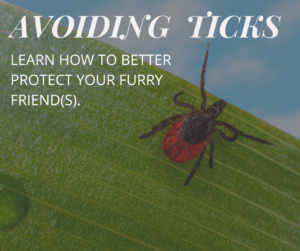 We understand that as a responsible pet owner you are concerned about ticks! Considering that they are a growing concern within Ontario, it is important to ask questions about them. Along with the COVID-19 pandemic came a lot more time for walking/hiking in our area with more chances to run into one of these pesky parasites! Below you will find information everyone should know in regards to ticks and preventing them!
We understand that as a responsible pet owner you are concerned about ticks! Considering that they are a growing concern within Ontario, it is important to ask questions about them. Along with the COVID-19 pandemic came a lot more time for walking/hiking in our area with more chances to run into one of these pesky parasites! Below you will find information everyone should know in regards to ticks and preventing them!
WHAT ARE TICKS?
Did you know that ticks are actually classified in the same group as spiders (Arachnida) and that they have been around for an estimated 90 million years!? A tick is a type of parasite that is not able to fly or jump. Instead, ticks use their 8 legs to crawl and attach to hosts. During the winter season here in Canada, ticks are hidden in debris and other warm places they can find. As soon as the outside temperature reaches 0 degrees Celsius, they can begin to emerge.
WHY DO TICKS BITE?

Ticks require blood in all stages of life to survive and that is where we (and our pets!) come in. Ticks are attracted to warmth and even certain smells. It is a common misconception that only outdoor pets can be bitten by a tick. This is not true! Ticks can be brought into homes unknowingly from other pets and clothing. This is why it is important to know what to look out for and make sure both outdoor and indoor pets are protected.
EFFECTS OF TICKS & PREVENTING THEM.
These pesky parasites are able to carry diseases that can have long-term effects on both humans and animals. Dogs particularly can suffer from Lyme disease, ehrlichiosis and rocky mountain spotted fever. Cats can be at risk for cytauxzoonosis (infection resulting in hemorrhaging) and haemobartonellosis (which affects oxygen supply). It is important to be aware of ticks when you walk through any long grass or open fields as these are considered higher-risk areas for ticks. Although they can be tricky pests to spot once they have bitten they usually appear to be a small growing bump on your pet’s skin that was not present before. A tick will become engorged when left on a host and becomes more noticeable with time.
Our veterinarians can help you find the best tick prevention for your furry friend. This can include chewable and topical options for both cats and dogs. It is a good opportunity to discuss tick prevention at your pet’s yearly wellness visit as there are multiple options available depending on your pet’s needs. Let us work together to keep these parasites away from our purr-fect friends!
Sources:
https://healthypets.mercola.com/sites/healthypets/archive/2015/07/19/tick-borne-diseases-cats.aspx
https://www.medicinenet.com/ticks/article.htm
https://vcacanada.com/know-your-pet/rocky-mountain-spotted-fever-in-dogs
https://veterinarypartner.vin.com/default.aspx?pid=19239&id=49520
